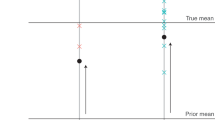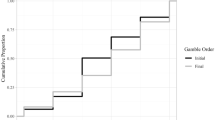Abstract
Richard Pettigrew has recently advanced a justification of the Principle of Indifference on the basis of a principle that he calls “cognitive conservatism,” or “extreme epistemic conservatism.” However, the credences based on the Principle of Indifference, as Pettigrew formulates it, violate another desideratum, namely, that learning from experience be possible. If it is accepted that learning from experience should be possible, this provides grounds for rejecting cognitive conservatism. Another set of criteria considered by Pettigrew, which involves a weighted mean of worst-case and best-case accuracy, affords some learning, but not the sort that one would expect. This raises the question of whether accuracy-based considerations can be adapted to justify credence functions that permit induction.
Similar content being viewed by others
Notes
The concept of a Superbaby, though not the term, is due to Good (1968, p. 157). Hájek (ms.) reports that David Lewis coined the term. Good himself says that imagining such a baby is the “closest I can get to giving … a practical significance” to credence in the absence of all empirical knowledge. The language he uses suggests that, in his estimation, “closest” is not very close.
For simplicity, we’re assuming that Π(ti) has the same cardinality n for each time ti, but nothing in the argument depends on this. However, for Pettigrew’s argument to apply, the partition considered by the Superbaby must be finite, and so we can consider only a finite set of times and, for each time, a finite partition of ways the world could be at that time.
What counts as “high enough” is that the weight, λ, accorded to best-case accuracy be greater than or equal to 1/n, where n is the number of elements of the partition considered.
This was pointed out to the author by Pettigrew in a personal communication.
See chapters 1, 2, 4, and 11 of Zabell (2005) for discussion, and some of the history.
References
Carnap, R. (1945). On inductive logic. Philosophy of Science, 12, 72–97.
Carnap, R. (1950). The logical foundations of probability (1st ed.). Chicago: The University of Chicago Press.
Carnap, R. (1962). The logical foundations of probability (2nd ed.). Chicago: The University of Chicago Press.
Good, I. J. (1968). The White Shoe Qua Herring is Pink. The British Journal for the Philosophy of Science, 19, 156–157.
Hájek, A. (ms.). “Staying regular?” http://hplms.berkeley.edu/HajekStayingRegular.pdf.
Pettigrew, R. (2016a). Accuracy, risk, and the principle of indifference. Philosophy and Phenomenological Research, 92, 35–59.
Pettigrew, R. (2016b). Accuracy and the laws of credence. Oxford: Oxford University Press.
Zabell, S. L. (2005). Symmetry and its discontents. Cambridge: Cambridge University Press.
Acknowledgements
I thank Richard Pettigrew and John Norton for helpful comments on an earlier draft of this article. I am grateful to Graham and Gale Wright, who generously sponsor the Graham and Gale Wright Distinguished Faculty Award at the University of Western Ontario, for funding that supported this work.
Author information
Authors and Affiliations
Corresponding author
Rights and permissions
About this article
Cite this article
Myrvold, W.C. Learning is a Risky Business. Erkenn 84, 577–584 (2019). https://doi.org/10.1007/s10670-018-9972-0
Received:
Accepted:
Published:
Issue Date:
DOI: https://doi.org/10.1007/s10670-018-9972-0




